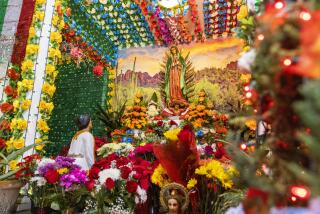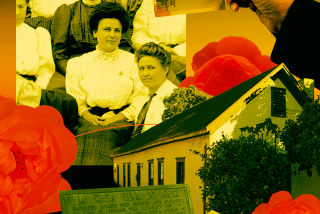Sunday’s Observance Will Honor Veterans of U.S. Wars : San Juan Mission Barracks to Be Rededicated
- Share via
A rough adobe barracks building erected almost 200 years ago for a tiny garrison of Spanish soldiers stationed at the then-new Mission San Juan Capistrano will be rededicated Sunday in services honoring veterans of all wars in America’s history.
The ceremony, scheduled 10 days before the national celebration of Veterans Day, will give special recognition to a handful of community area residents who took part in U.S. battles as far back as World War I.
One of the three small barracks rooms, closed to the public for many years, has been furnished with relics and replicas of the gear of about a dozen Spanish soldiers who moved in when the building was first dedicated in 1791.
The tile-roofed building, which now will be open daily to the public, has floors of rock and dirt. Cots with colorful blankets are arranged in rows; replicas of muskets stand in racks; shields and jackets of deerskin hang on the walls, and serape-covered tables hold platters of make-believe vegetables and round loaves of bread.
“There never were more than 12 soldiers here at one time, and these guys had very pleasant duty,” said Nicholas Magalousis, director of the mission museum. “They had the climate, the ocean nearby and they didn’t have to fight anybody--just be here. Most of them had been garrisoned at San Diego’s Mission before being sent here.”
During their time in San Diego, Magalousis said, “some of them almost certainly came in contact with or were treated by” a Spanish army doctor named Pedro Prat, who had arrived from Spain in 1769 aboard the San Antonio, along with Fra Junipero Serra and Capt. Gaspar de Portola, the men who were to establish the trail of California missions.
Prat, a graduate of the University of Barcelona, “practiced as well as circumstances allowed,” but he also needed the help of local Luisaino Indians, according to Dr. Edward Pier Roemer, a retired physician and amateur archeologist from Capistrano Beach.
The Indians taught him the use of herbs such as jimson weed and the bark of spruce trees to make tonics for treatment of scurvy and dysentery, Roemer said. Prat was able to return the favor a few years later, when he treated 67 Indians who had been wounded in a brief 1775 uprising against the Spanish soldiers and missionaries.
According to Magalousis, the Luisaino Indians “had been very friendly at first,” but within a year or two began to resent changes in what they had considered their stable life style, a resentment that eventually erupted into physical violence.
It apparently was the first time the Indians had encountered firearms, Roemer said, because “they were amazed to see their comrades fall down when they couldn’t see anything hit them.”
A few days after the fight, the wounded ones came to Prat for help. Roemer said he still thinks that this exchange of services--treatment of scurvy and dysentery and treatment of bullet wounds--is a high mark in the medical profession’s tradition of helping friend and foe alike.
Although a crude infirmary was built on the San Juan Mission grounds near the barracks, the Spanish doctor apparently was never stationed there, Roemer said, but some years later was sent from the San Diego Mission to the mission at Monterey.
Magalousis said said the refurbishing of the barracks room was made possible by a $10,000 donation from the Mission Docent Society, along with hours of volunteer work. He said the two other rooms are still being restored.
Sunday’s rededication program will begin at 2 p.m., marking the opening to the public of the three-room building for the first time in many years and honoring 13 local people who are veterans of U.S. wars and conflicts dating back to World War I, Magalousis said.
Those to be honored are Paul Arbiso, who fought in World War I; World War II veterans Floyd Nieblas, Clayton Ward and John Tatum; Tony Forster, Ray Brucks and Lester Hunt, who served in the Korean conflict, and Vietnam War veterans Julian Ramos, Tom Hribar, Del Maze, Nicholas Magalousis, Craig Thomas and Charlotte Engelke.
More to Read
Sign up for Essential California
The most important California stories and recommendations in your inbox every morning.
You may occasionally receive promotional content from the Los Angeles Times.










